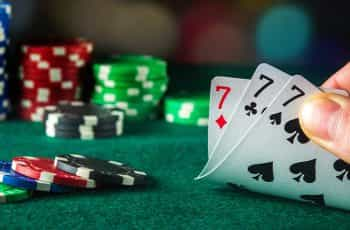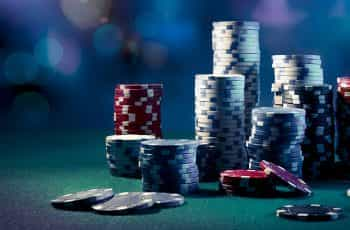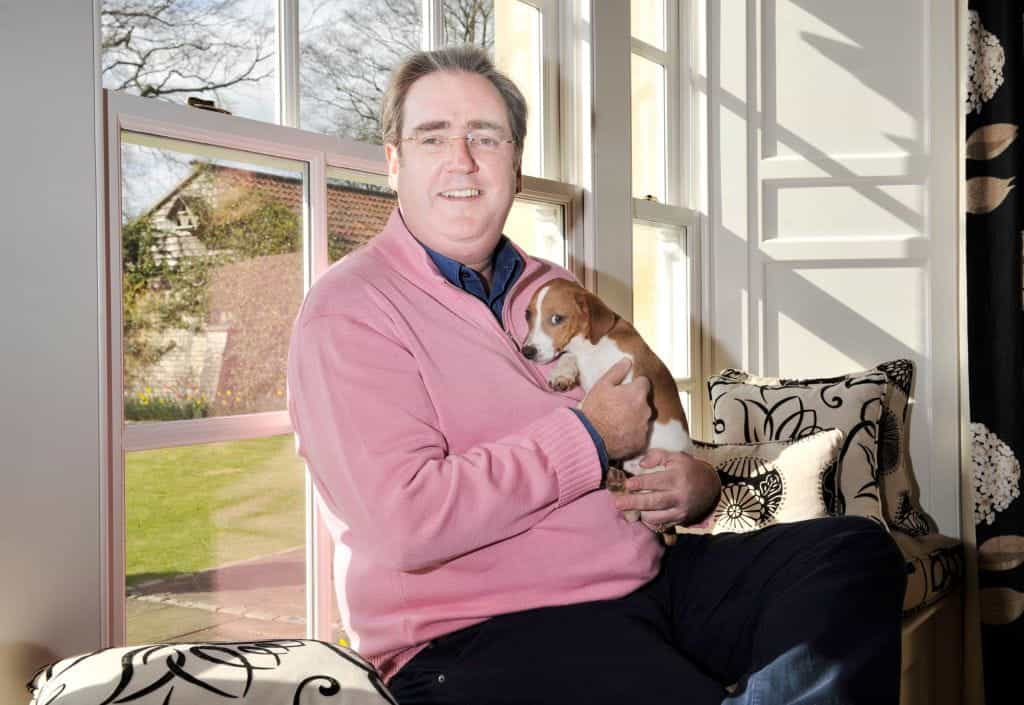
Findlay Was Not Ramsden Reinvented
Loud, often abrasive, and never afraid to speak his mind, Harry Findlay was a big-time gambler . Many would say those are four good reasons why horseracing’s establishment would take a dim view of anyone.
His like had been seen before. In the 1980s Terry Ramsden, a flamboyant mullet-wearing North Londoner made a fortune trading in Far Eastern stock markets. With millions in the bank, he took to plowing fortunes into horseracing ownership and betting on the sport.
Ramsden may have been astute in the stock markets but in the betting markets he was a disaster. By the time the 1987 Black Monday global stock market crash conspired to wipe out his business, it is believed he had lost over £50 million gambling on British horse racing. Furthermore, he had been banished from the sport.
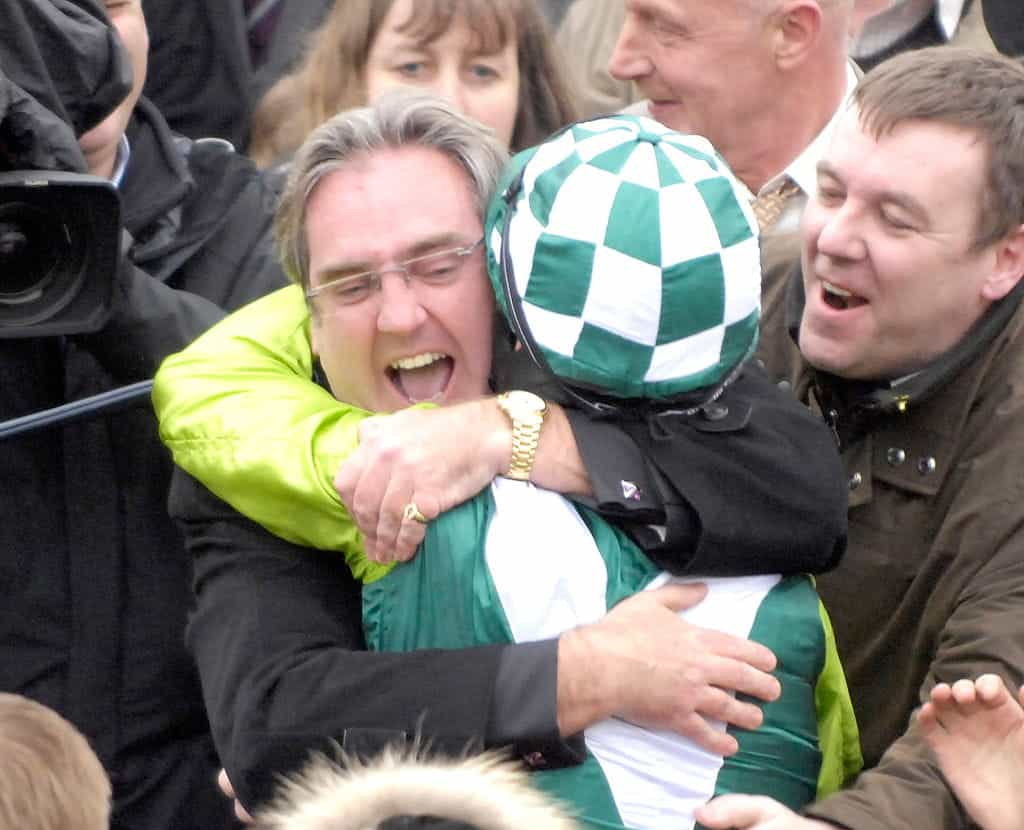
Harry Findlay celebrates with jockey Sam Thomas after Denman had won the Gold Cup for the part-owner. ©GettyImages
Harry Findlay was cut from a different cloth. There was no family fortune behind him. He had not made his money from a dot-com business – the ‘naughties’ equivalent of the 80s stock-market big bang which created 1,500 millionaires overnight – he was and always had been a gambler.
A Bad Start
A version of Harry Findlay’s story can be found in ‘Gambling for Life – Harry Findlay’ the authorized biography penned by Neil Harman published in September 2017. Here you will read about his teenage years when long-defunct dog tracks at Hackney, Slough, White City, and a local betting office were his playgrounds.
He was to run up a £1,400 bill with the independent bookmaker who pressed so hard for his money he delivered a wreath to the 16-year-olds house. Findlay’s mother, scared for her son’s wellbeing, took out a loan to pay the debt. She would bail him out many more times in the future.
By the age of 20, Harry Findlay was out of control and part-way through a two-year jail sentence for credit card fraud. Clearly, he was not always a good gambler, and he needed lessons in responsible gambling, but things would change.
The Roller Coaster Begins
Following this stark introduction to his early life, Harry Findlay’s no holds barred ‘Gambling for Life’ account follows highs, some incredible highs, stratospheric highs, and comes full-circle to a relatively low point where the 368-page memoir concludes.
However, Harry Findlay’s version of events depicts his side of a complex story and tellingly, in his introduction, the author noted: “Harry has enough material to fill three books. Probably half a dozen.”
Most people can recall their first encounter with Harry Findlay. His ‘shout it from the rooftops’ style when he has backed a winner is not designed to offend. Nevertheless, it is hard to ignore and can be irksome.
But first impressions can be deceptive and, for anyone who has ever engages with him, it quickly becomes clear that Findlay’s brashness should never be confused with arrogance. Harry Findlay is exuberant, he is loud – you could hear him talk at a rock concert – but he is sincere, genuine and very generous.
Poacher Turned Gamekeeper
On his return to society, Findlay, determined to end what he described as his “compulsive gambling”, put his prodigious mathematical skills to work. Betting on golf, snooker, tennis, football, greyhound racing and other sports, his flair and eye for an angle was obvious for all to see.
Spread betting firm City Index, probably on the wrong end of some sizeable exchanges with him, were amongst the first to spot Findlay’s talent. In classical poacher turned gamekeeper fashion, at one stage he was put on their payroll.
As the 90s dawned, Findlay had acquired a lot of money, enough to buy a fast greyhound and enjoy a champagne lifestyle. But, when the results went against him and he could no longer pay relatively minuscule kennel fees, Chicita Banana became the property of her trainer.
His pride and joy was not all that he lost and the character, by now known as ‘Harry The Dog’, temporarily disappeared from the greyhound world. As he confesses to numerous times in the pages of ‘Gambling for Life’, he turned to his mother for help.
Taking the Biscuit
Reflecting on this time, an anecdote not listed in ‘Gambling for Life’ but often told by Findlay was the story of when he got word of a bout of sickness that had ravaged a leading football team. Resultantly they were set to field a squad made up of teenagers and a few adolescents at the coming weekend’s match. To Findlay, the task was obvious – shovel whatever money he could muster on the opposition. It meant a visit to the bank of mum.
The loan application, using her home as collateral, went through so late in the day bundles of cash were placed in a biscuit tin and delivered to Harry, over 100 miles away, via a flagged-down taxi driver. Thankfully he was completely oblivious to his cargo and did not become overcome with hunger at any point of the long journey.
By kick-off, and before the public was aware an academy team and a few ball-boys were representing the home side, Findlay had exchanged the readies for a handful of betting slips potentially worth a small fortune.
His investments looked guilt-edged as his team led 3-1 heading into the 92nd minute. Three minutes later those slips were sat on the terrace floor, worthless. A Roy of the Rovers storyline had seen the kids find the back of the net not once but twice during injury time.
Harry’s Back and on the BBC
But Findlay is tenacious and the ability to find and exploit opportunities gradually saw him pay off his debts, claw his way back into the betting business, and come under the spotlight. In 1997 a BBC documentary followed Harry Findlay for a period as he punted amongst friends and at dog tracks around the UK.
If that program raised his profile France winning the 1998 World Cup at double-figure odds boosted his bankroll immeasurably. He returned to the greyhound fold buying another star, Big Fella Thanks, who would win the Clonmel Coursing Derby for him in 1999.
The Operation Bloomed
Along this journey, Findlay made many friends and acquired plenty of associates. A network of like-minded people makes for a consensus that combined can produce an opinion that is better, more pertinently more accurate, than a team of bookmaker odds compilers.
Two of these characters are pivotal to Harry’s tale. The first is the notoriously secretive Brighton and Hove Albion chairman Tony Bloom. The second is Glen Gill.
Nicknamed ‘The Lizzard’, Bloom devised and employed football betting techniques that were well ahead of their time – the use of data-hungry algorithms, Asian handicaps, et al – when working for bookmaker Victor Chandler in the 1990s.
Findlay’s alliance with the genius in-play football gambler clearly helped finance the good times’ Harry Findlay enjoyed for much of the late 1990s into the 2000s. In ‘Gambling for Life’ it is made very clear their allegiance, whilst primarily run and operated by Bloom, paid Findlay out like a broken slot machine.
A Lively Knight
Glen Gill cut his betting teeth at Portsmouth dog track, so the pair were destined to meet and become close friends. Gill made an appearance in Findlay’s 1997 BBC documentary, but he was soon to become better known for his arrest and subsequent charge of conspiracy to defraud bookmakers and gamblers.
The Metropolitan Police and authorities believed they had a strong case against Gill and four other individuals accused of doping two horses: Lively Knight and Avanti Express. Both were beaten as long odds-on favorites and post-race both were found to have been injected with the ‘stopper’ acetylpromazine (ACP).
Some video footage of the accused acting suspiciously at the racecourse on race day, a syringe containing ACP found in one of the defendant’s homes and phone records between the accused had been offered up in evidence.
But despite a three-and-a-half-year inquiry costing £3 million, all five of the accused were acquitted by the judge. In December 2000, the Jockey Club had to lift an Exclusion Order on Glen Gill and one other individual.
The Sport of Kings
Given this history it is very likely Gill remained on the British Horseracing Authority’s (BHA) radar. Doubtlessly some eyebrows were raised when he was appointed racing manager to Harry Findlay just a few years after the costly race-fixing accusations.
Findlay had not abandoned greyhound racing, far from it. He had taken out a trainer’s license in his own name and bought some very expensive dogs. But, by the early 2000s, he had also begun to buy into horse racing. His interest saw him own a string of bloodstock primarily in partnership with Bloom, Paul Barber, and later the Sangster family.
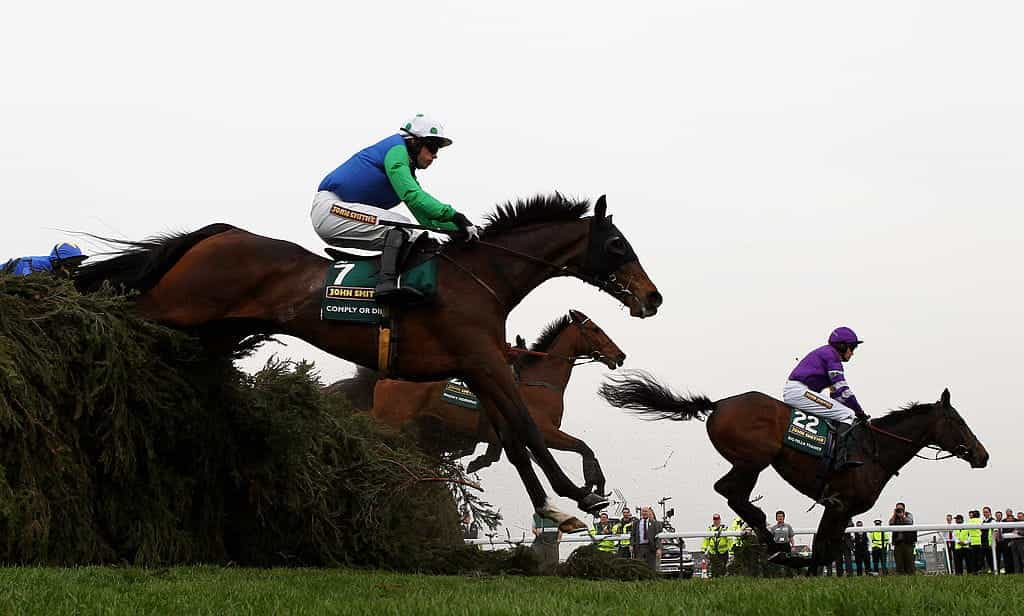
The Harry Findlay owned Big Fella Thanks leading Comply or Die and Snowy Morning in the 2010 Grand National. ©GettyImages
Success on course simply fueled a spending spree. Ignoring the prestige involved with winning the Royal Sun Alliance Chase and the 2008 Gold Cup at the Cheltenham Festival, the hundreds of thousands he won backing Denman ante-post in these races saw Findlay become involved with over 40 horses.
With every winner and result, Findlay heaped praise on Gill. Terms such as “genius” and the “best horse judge ever” were regularly bounded about. Findlay still speaks of his friend in the same high regard today albeit times have very much changed.
Findlay’s Most Successful Horses and Greyhounds
Over the course of thirty years the Findlay name has appeared on race cards alongside the names of some brilliantly talented horses and greyhounds. Here’s just a few of those greats:
- Denman: Bult up a sequence of 14 wins from 15 starts and landed the Cheltenham Gold Cup
- Chicita Banana: Won the Golden Jacket competition and broke the Wembley track record
- Big Fella Thanks (greyhound): Landed the Coursing Derby at Clonmel Festival
- High Standing: Royal Ascot winner also placed in the Group One Betfred Sprint Cup
- Big Fella Thanks (horse): Started favorite and made the frame in the 2010 Grand National
- Beshabar: Won the valuable Betfair Ascot Hurdle and Scottish Grand National
Of course, not every horse or greyhound Findlay has owned has been a superstar. It is estimated he has owned or part-owned over 150 horses spread across 15 stables. Many of his most expensive purchases did not go on to achieve great things.
Fixing to Lose
By early 2010, Bloom and Findlay’s relationship had hit turbulence and ‘Gambling for Life’ makes it clear a huge revenue stream had dried up. So, a cull in the Findlay horseracing empire may have already been underway.
In June of that year, Findlay found himself in a BHA steward’s room being forced to defend himself. The charge was placing trades on his own horse to be beaten. He never denied the charge but had to explain Glen Gill had been placing bets on the Betfair Exchange on his behalf.
To the layman backing your own horse to lose smacks of skullduggery but a close inspection of Findlay’s betting account clearly showed he had backed his own horse, Gullible Gordon, to win more money if the horse won than if he had been beaten.
In October 2008, while backing and almost simultaneously laying Gullible Gordon, Findlay’s bets on the race (placed by Gill) ultimately showed a potential £23,755 profit if his horse had won and a loss of £62,321 if it had lost. The horse did lose, and the punter was out of pocket. This was no fixed race. There was no suggestion of dishonesty.
64,000 Reasons
One year later, there was a second incident, regarding the same Findlay-owned horse. Once again, it was Gill who had pressed the buttons on the Betfair Exchange on Harry’s behalf. This time he had overwhelmingly backed the horse to win with a similar few ‘minimize potential loss’ trades placed as a saver.
The betting records produced at the hearing showed a total of £64,000 was staked at prices from 1.89 down to 1.66 before the race. The vast majority of this, £56,000 was on the horse to win. Four lay bets were matched in running risking a total of £9,223 for a potential win of £32,034.
Gullible Gordon led throughout the three-mile novice chase, meaning the owner had won £35,245. If the horse had been beaten, he would have lost £31,966.
Despite clearly backing his horse to win and a loss on either occasion would represent a loss, authorities deemed this activity to be a breach of the rules. Gill could not be held accountable for any rule breach, but Findlay paid the price, and he was banned from the sport for six months.
Going Back to the Dogs
On appeal, Findlay’s punishment was later reduced to a fine. But, in the belief he was the victim of a political witch-hunt, he declared he was finished with the sport and sold up his interests during the next 12 months.
It was time to return to greyhound racing, his first love, but the Findlay fortune slowly haemorrhaged away as he attempted to make Coventry’s Brandon Stadium the center of the greyhound world.
Leasing Coventry was extremely costly and his many attempts to get the track’s action broadcast into betting shops – something that brings considerable revenue – failed. When the gates closed for the final time, Harry Findlay had wiped out the remainder of his bankroll. He says that he spent £1.7 million on this greyhound adventure.
Spending a Fortune Generously
The betting fraternity knew Harry Findlay would never disappear quietly into the night. After all, you cannot keep a good man down. The launch of 2017’s ‘Gambling for Life’ put him in the spotlight once more.
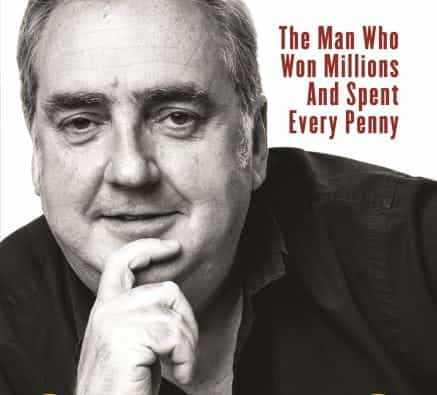
Harry Findlay had a lot of money to spend. ©ReachSport
It is a fascinating read with a byline ‘The Man Who Won Millions and Spent Every Penny’. As the book makes it pretty clear he finished up on his knees, you may question what is his definition of ‘spent’?
And therein lay Findlay’s star quality: generosity. Material wealth is clearly not and never has been on his radar. The last of his fortune being plowed into a dog track was never a case of a business slowly failing. It was him supporting a sport, and the people involved in it, which he loved.
You can rest assured when he had a big winner every member of the kennel or stable staff would have enjoyed some part of his financial spoils. Even on the losing nights, a post-racing visit to a curry house would resemble a refugee column. Harry would fund these feasts every time.
Charity Begins
During the good times, Harry’s life was all about helicopter rides, jets, five-star hotels, and private boxes at the world’s finest sporting events.
Rarely reported were his acts of generosity. There are several including the tale of him encountering a young child with special needs making a bucket collection at a racecourse. Findlay was so taken with the cause and the young individual – who was a Celtic football fan – he organized and funded a trip for him and his classmates to see the team in action.
It was no ordinary trip to a match. You can only speculate what a private jet to Barcelona, 12 front row seats at Camp Nou, spending money, appropriate accommodation for children and their carers, and transfers cost Findlay.
Living Life in Lifford?
So, where is Findlay now and what’s next for the extroverted gambler who has been doing his unique brand of ‘thing’ for some part of the past six decades? The latest local press reports suggest he is about to resurface with an interest in his beloved greyhound racing once again.
Lifford Greyhound Stadium, situated in sparsely populated County Donegal, Ireland, may have closed two years ago but newspaper stories mention his name aplenty amongst reports “a dynamic group of local and international investors alongside the UK Tote Group are to form a unique collaboration with a clear strategy on how to revitalize the stadium.”
Will this latest project prosper, or will it fail? If Harry Findlay is involved, it will certainly not lack enthusiasm, and you can be sure there will be plenty of bubbly in the restaurant fridge.
What are Harry Findlay’s biggest wins and losses?
In ‘Gambling for Life’ Finlay indicates he won over £1 million on Denman at the Cheltenham Festival. His biggest individual sports betting loss was £2.5m incurred when New Zealand failed to win the 2007 Rugby World Cup.
How good was Denman the horse Findlay owned a half-share in?
Denman was an exceptional animal, a horse racing betting win machine. He was nicknamed ‘The Tank’ because of his ability to plow through a fence without it seemingly causing him any loss of momentum. In addition to winning the Cheltenham Gold Cup, he finished second in the showpiece race on three further occasions. Other major victories included the Challow Hurdle, Aon Chase, Lexus Chase and two editions of the Hennessy Gold Cup.
Did Harry Findlay have much success training his own greyhounds?
He did, Tobermory Boy and Lagarto Dorado were amongst his best dogs. However, Harry would be the first to admit whilst he held the training license it was his friend Don Cuddy, an Irish veteran who used to train greyhounds in America, that handled his dogs. Check out a list of Harry Findlay's most successful greyhounds and racehorses.
